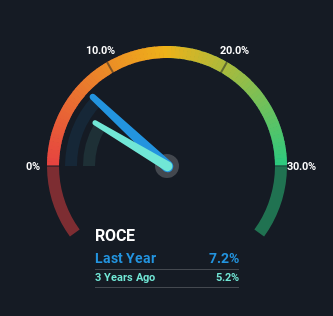The Returns On Capital At Sangam (India) (NSE:SANGAMIND) Don't Inspire Confidence

To find a multi-bagger stock, what are the underlying trends we should look for in a business? One common approach is to try and find a company with returns on capital employed (ROCE) that are increasing, in conjunction with a growing amount of capital employed. Ultimately, this demonstrates that it's a business that is reinvesting profits at increasing rates of return. However, after briefly looking over the numbers, we don't think Sangam (India) (NSE:SANGAMIND) has the makings of a multi-bagger going forward, but let's have a look at why that may be.
Return On Capital Employed (ROCE): What Is It?
For those that aren't sure what ROCE is, it measures the amount of pre-tax profits a company can generate from the capital employed in its business. The formula for this calculation on Sangam (India) is:
Return on Capital Employed = Earnings Before Interest and Tax (EBIT) ÷ (Total Assets - Current Liabilities)
0.072 = ₹1.2b ÷ (₹27b - ₹11b) (Based on the trailing twelve months to March 2024).
Thus, Sangam (India) has an ROCE of 7.2%. Ultimately, that's a low return and it under-performs the Luxury industry average of 10%.
Check out our latest analysis for Sangam (India)

While the past is not representative of the future, it can be helpful to know how a company has performed historically, which is why we have this chart above. If you're interested in investigating Sangam (India)'s past further, check out this free graph covering Sangam (India)'s past earnings, revenue and cash flow.
So How Is Sangam (India)'s ROCE Trending?
In terms of Sangam (India)'s historical ROCE movements, the trend isn't fantastic. Over the last five years, returns on capital have decreased to 7.2% from 9.9% five years ago. Meanwhile, the business is utilizing more capital but this hasn't moved the needle much in terms of sales in the past 12 months, so this could reflect longer term investments. It may take some time before the company starts to see any change in earnings from these investments.
The Key Takeaway
Bringing it all together, while we're somewhat encouraged by Sangam (India)'s reinvestment in its own business, we're aware that returns are shrinking. Investors must think there's better things to come because the stock has knocked it out of the park, delivering a 1,128% gain to shareholders who have held over the last five years. But if the trajectory of these underlying trends continue, we think the likelihood of it being a multi-bagger from here isn't high.
Sangam (India) does come with some risks though, we found 4 warning signs in our investment analysis, and 1 of those shouldn't be ignored...
If you want to search for solid companies with great earnings, check out this free list of companies with good balance sheets and impressive returns on equity.
New: Manage All Your Stock Portfolios in One Place
We've created the ultimate portfolio companion for stock investors, and it's free.
• Connect an unlimited number of Portfolios and see your total in one currency
• Be alerted to new Warning Signs or Risks via email or mobile
• Track the Fair Value of your stocks
Have feedback on this article? Concerned about the content? Get in touch with us directly. Alternatively, email editorial-team (at) simplywallst.com.
This article by Simply Wall St is general in nature. We provide commentary based on historical data and analyst forecasts only using an unbiased methodology and our articles are not intended to be financial advice. It does not constitute a recommendation to buy or sell any stock, and does not take account of your objectives, or your financial situation. We aim to bring you long-term focused analysis driven by fundamental data. Note that our analysis may not factor in the latest price-sensitive company announcements or qualitative material. Simply Wall St has no position in any stocks mentioned.
Have feedback on this article? Concerned about the content? Get in touch with us directly. Alternatively, email editorial-team@simplywallst.com
About NSEI:SANGAMIND
Sangam (India)
Engages in the manufacture and sale of PV-dyed yarns and denim fabrics in India.
Slight second-rate dividend payer.
Similar Companies
Market Insights
Community Narratives



